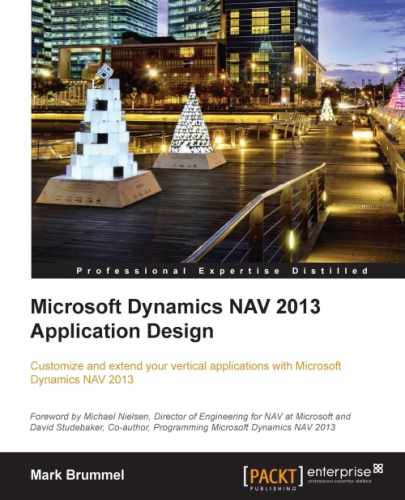In 1997, the company I worked for was looking to replace their MS-DOS-based software package. We were very fortunate in finding Navision Financials 1.1 as a software package that supported the upcoming Windows platform and was flexible enough to be implemented, supporting our demands.
Even though the standard functionality was nowhere near what we have today, the structure of the application design was simple and solid and has not changed since then.
In the years after that, more companies embraced Navision as their answer to the changing demands in the market, and many vertical solutions that still exist today started their life cycle. With the acquisition of Navision by Microsoft, the interest of new partners grew into the channel we know today.
Microsoft Dynamics NAV offers a unique development experience that can only be fully used once you understand how the standard application parts are designed.
When properly licensed, everyone can change how the application works. With this great possibility comes great responsibility as this means that we can also easily break important business logic.
This results in a unique need for a designer of applications that run inside Microsoft Dynamics NAV to know more about the application without going into deep functional details.
The balance in this book will be between learning and understanding how the standard application features of Microsoft Dynamics NAV are designed, and how to use this knowledge when designing our own solutions. The area between understanding the application functionality and technical design is very thin.
In this book, we will make both changes to the standard application and create new solutions. We will also discuss how Microsoft Dynamics NAV can work with other applications.
Chapter 1, Introduction to Microsoft Dynamics NAV, will introduce you to Microsoft Dynamics NAV. We will briefly talk about the history of the application and talk about the concepts. We will cover some of the basic design patterns such as Number Series and Navigation. Then we will discuss the data model principles used by Microsoft Dynamics NAV using master data, journals, and ledger entries covered by documents.
Chapter 2, A Sample Application, will implement the theory you learned in the first chapter in a sample application. The goal of this chapter is to better understand how Journals and Ledger entries work throughout the system, and how to create your own Journal application. You will learn how to reverse engineer the standard application to learn from it and apply this to your own customizations. We will integrate the application with relationship management and sales in Microsoft Dynamics NAV, and extend Navigation and Dimensions for our solution.
Chapter 3, Financial Management, will explore how the financial management part of the application can be used and how it is designed. This is the heart of Microsoft Dynamics NAV. You will learn important concepts such as VAT and TAX, posting groups, closing dates, entry application, and financial data analysis. We will make some changes in the core application, adding new information to the general ledger, and learn how to integrate financial management into our add-on solution.
Chapter 4, Relationship Management, will help you to analyze the sales data in our system and be more productive towards your customers. We will explore the unique design of this part of the application and integrate this with the sample application we created in Chapter 2, A Sample Application.
Chapter 5, Production, will show us how to set up Microsoft Dynamics NAV for production companies. These companies are at the start of the supply chain. We will discuss the assembly management and manufacturing. Item Costing and Item Tracking are the key elements when using this part of the application. We will look at the planning worksheet, and how to create production orders using Make-to-Order and Make-to-Stock policies. We will reverse engineer the Inventory Profile Offsetting codeunit and see how this leads to planning and purchase orders. At the end of this chapter, we will look at ten ways to customize production for vertical industries.
Chapter 6, Trade, will discuss the relationship between sales, inventory management, and purchasing, and how warehousing can be involved using different levels of complexity. Without sales, most companies will not survive. We will learn how reservation entries are used in the system from a technical perspective.
Chapter 7, Storage and Logistics, will design and build a solution for planning routes for shipments, a feature that is not available in Microsoft Dynamics NAV. We will design a solution that can be used by trading companies not only for their own shipments but also for storage companies. The solution is seamlessly integrated with the Dynamics NAV product. We will extend the Journal knowledge that we learned in Chapter 2, A Sample Application and Chapter 3, Financial Management, with new document structures we learned in Chapter 5, Production and Chapter 6, Trade.
Chapter 8, Consulting, will discuss how to implement the Job functionality using four example jobs, and extend jobs with an issue registration and timesheet application using resource groups and calculations. The Jobs functionality in Microsoft Dynamics NAV can be compared to an add-on solution. It was designed outside financial management and trade but is still integrated into the product.
Chapter 9, Interfacing, will discuss how to design a rock solid business-to-business interface. In the last decade, interfacing has become a crucial part of designing and implementing ERP systems. We will show you which technologies are available to use for interfacing and how these technologies are implemented in the standard product. We will discuss all the built-in interfaces with other Microsoft applications such as Office, SharePoint, BizTalk, and Exchange.
Chapter 10, Application Design, will focus on the concepts of application design and how they apply to Microsoft Dynamics NAV. We will focus on design to use, maintain, support, upgrade, perform, and analyze. This includes concepts for the user interface, version management, and the development methodology.
Appendix, Installation Guide, will cover installation procedures associated with objects of Dynamics NAV.
